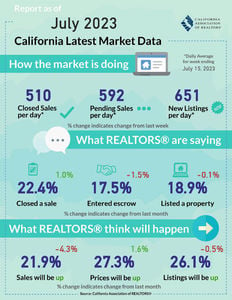 Despite interest rates that remain near 7%, the economy continues to perform well. Last week’s inflation report generated some confidence that things are improving more quickly in the Fed’s effort to tame rising prices. Consumers remain relatively optimistic and even new MBS issuances rose for the first time in over a year. The Federal Open Market Committee is set to meet next week and are expected to raise their benchmark rate 25 basis points, so mortgage rates may remain elevated over the short term. Thus far, buyers seemed to have rebounded modestly from the initial shock of rising rates and the market has grown more competitive as demand continues to outstrip supply.
Despite interest rates that remain near 7%, the economy continues to perform well. Last week’s inflation report generated some confidence that things are improving more quickly in the Fed’s effort to tame rising prices. Consumers remain relatively optimistic and even new MBS issuances rose for the first time in over a year. The Federal Open Market Committee is set to meet next week and are expected to raise their benchmark rate 25 basis points, so mortgage rates may remain elevated over the short term. Thus far, buyers seemed to have rebounded modestly from the initial shock of rising rates and the market has grown more competitive as demand continues to outstrip supply.
Inflation continues to cool, but Fed will still probably raise rates: Markets were pleasantly surprised last week when inflation cooled to just 3% on an annual basis, which is the lowest level in over two years. Last year, inflation was approaching the double-digits as costs rose on goods and services alike. Of note was a cooling in service sector prices, which is the source of much of the economic growth we’ve enjoyed over the past few years, despite ongoing job and wage growth in this sector. Some are hopeful that this may provide support for the Fed to begin dialing back their aggressive monetary policy, but many expect the Fed to raise interest rates at least one more time—starting with their FOMC meeting next week. That would put the Fed Funds Rate at 5.5%, and may seem unnecessary given the better-than-expected improvement in inflation last month, but it may help to avoid a second rate hike at the next FOMC meeting in September.
Consumer sentiment ramps up in July alongside businesses: The University of Michigan’s index of consumer sentiment rose to its highest level in almost two years as fears about a recession fade and the labor markets remain strong. Although consumers are still weary of inflation, they were more enthusiastic about their current economic situation, where they will be in a year economically, and nearly one-third of respondents expected their finances to have improved by next year. Part of this is due to a labor market where jobs remain relatively abundant—despite recent high-profile, specific layoffs, the aggregate numbers show and ongoing labor shortage. Business optimism also improved last month, driven mostly by reduced fears about a pending recession as economic data remains relatively upbeat.
California labor markets remain resilient: A few high-profile California financial firms faced several crises during the beginning of the year and shed jobs alongside some notable tech companies based in the Bay Area. However, California continued to add jobs in the aggregate as the service sector remained in growth mode as consumers continued to spend at bars, hotels, restaurants, and entertainment venues. There was an increase in new unemployment insurance claims at the beginning of April, when more that 50,000 new unemployment insurance claims were filed. This is small relative to even 2021, when new UI claims were reaching 6-figures per week, and certainly well below the numbers we saw in 2020. However, since April, new unemployment claims have been below 50,000 per week for the past 13 weeks, consecutively. In addition, continuing claims, which measures new filings and ongoing claims, dipped to 374,000 last week. This is the smallest number of workers on unemployment insurance since November of 2022.
Freddie Mac reports highest rates since November: The weekly Freddie Mac estimates for the average 30-year fixed rate mortgage rose to 6.96% last week, but this was prior to the latest inflation data. Since then, 10-year and 2-year Treasury Prices have increased as fears of more persistent price growth (and thus, a more aggressive Fed) ease. The yield curve remains inverted, but markets could be betting on a faster return to less aggressive monetary policy or even rate cuts next year. This has likely helped keep 10-year prices, in particular, relatively high and rates lower than normal spreads would suggest given a 5.25% Fed Funds Rate.
Mortgage applications suggest seasonal peak is behind us: Last week, the index of new mortgage purchase applications dipped to 145. That is a 26% decline from the same period last year and an 18% decline from the previous week. Mortgage applications typically peak in the spring (April-June), which pushes closed sales up in the subsequent months as buyers find and close on properties giving way to our typical homebuying season. Aggregating the weekly data shows that new purchase applications peaked in April this year and fell in May and June in addition to last week’s dip. However, California’s homebuying seasons have been running deeper into the fall in recent years and we may continue to see stable or even rising home sales as we get near the 4th quarter.


